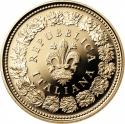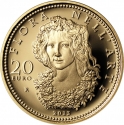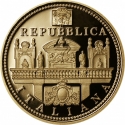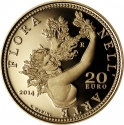You are about to finish your registration. Please check your mailbox (including spam folder). There should be a letter with a confirmation link. Check setting to make sure that your e-mail address is correct.
Send letter againDescription
In 2011 the Italian State Mint and Polygraphic Institute began a coin series entitled Flora and Fauna in Art Masterpieces. A Dual program with a €20 gold coin dedicated to flora or botanical themes, and a €50 gold coin inspired by fauna or zoological themes. The coins would illustrate and celebrate plant and animal life as portrayed in classical art through the ages.
Artist: Valerio De Seta
Obverse

|
Depicts a reproduction of the Trinacria, the symbol of Sicily (a Greek word that means ‘three pointed’ it recalls the shape of the island, which resembles a triangle), represented by the head of the Gorgon, whose hair is made of snakes, on three legs bent on their knee. Around, the inscription “REPUBBLICA ITALIANA”. REPUBBLICA ITALIANA⠂ |
|---|---|
Reverse

|
Depicts a detail from the mosaic in the Ruggero Room in the Palazzo dei Normanni, representing two peacocks surrounded by luxuriant vegetation. At the base of the work the name of the author “V. DE SETA”, the mintmark “R”, the face value “20 EURO” and the year of issue “2012”; below the arch-shaped inscription “FLORA NELL’ARTE”. V. DE SETA |
| Edge |
20 Euro
Flora and Fauna in Art Masterpieces
Flora: Middle Ages - Arab-Norman
Subscribe series
KM# 352
Flora and Fauna in Art Masterpieces
Flora: Middle Ages - Arab-Norman







